Related Research Articles

Artificial insemination (AI) is the deliberate introduction of sperm into a female's cervix or uterine cavity for the purpose of achieving a pregnancy through in vivo fertilization by means other than sexual intercourse. It is a fertility treatment for humans, and is common practice in animal breeding, including dairy cattle and pigs.
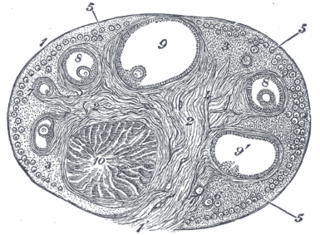
The corpus luteum is a temporary endocrine structure in female ovaries and is involved in the production of relatively high levels of progesterone and moderate levels of estradiol and inhibin A. It is the remains of the ovarian follicle that has released a mature ovum during a previous ovulation.

Dairy cattle are cattle cows bred for the ability to produce large quantities of milk, from which dairy products are made. Dairy cows generally are of the species Bos taurus.
The estrous cycle or oestrous cycle is the set of recurring physiological changes that are induced by reproductive hormones in most mammalian therian females. Estrous cycles start after sexual maturity in females and are interrupted by anestrous phases or by pregnancies. Typically, estrous cycles continue until death. Some animals may display bloody vaginal discharge, often mistaken for menstruation.
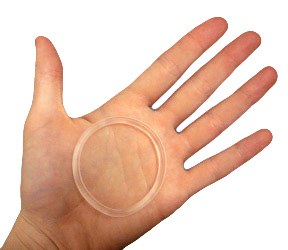
Vaginal rings are polymeric drug delivery devices designed to provide controlled release of drugs for intravaginal administration over extended periods of time. The ring is inserted into the vagina and provides contraception protection. Vaginal rings come in one size that fits most women.
Ovulation induction is the stimulation of ovulation by medication. It is usually used in the sense of stimulation of the development of ovarian follicles to reverse anovulation or oligoovulation.
Controlled ovarian hyperstimulation is a technique used in assisted reproduction involving the use of fertility medications to induce ovulation by multiple ovarian follicles. These multiple follicles can be taken out by oocyte retrieval for use in in vitro fertilisation (IVF), or be given time to ovulate, resulting in superovulation which is the ovulation of a larger-than-normal number of eggs, generally in the sense of at least two. When ovulated follicles are fertilised in vivo, whether by natural or artificial insemination, there is a very high risk of a multiple pregnancy.
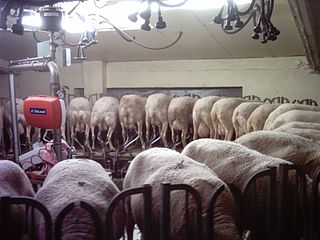
Sheep's milk is the milk of domestic sheep. It is commonly used to make cultured dairy products such as cheese. Some of the most popular sheep cheeses include feta (Greece), ricotta (Italy), and Roquefort (France).
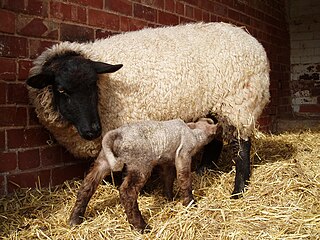
Domestic sheep reproduce sexually much like other mammals, and their reproductive strategy is furthermore very similar to other domestic herd animals. A flock of sheep is generally mated by a single ram, which has either been chosen by a farmer or has established dominance through physical contest with other rams. Most sheep have a breeding season (tupping) in the autumn, though some are able to breed year-round.

Intravaginal administration is a route of administration where the substance is applied inside the vagina. Pharmacologically, it has the potential advantage to result in effects primarily in the vagina or nearby structures with limited systemic adverse effects compared to other routes of administration.
CIDR is Classless Inter-Domain Routing, a method for allocating IP addresses and routing Internet Protocol packets.

Fertility testing is the process by which fertility is assessed, both generally and also to find the fertile window. General health affects fertility, and STI testing is an important related field.
Progesterone devices are broadly used in the control of reproductive management in livestock. They work by increasing circulating plasma progesterone levels with the following consequences:
- Progesterone suppresses the secretion of gonadotropin-releasing hormone (GnRH) from the hypothalamus. This is done via a negative feedback to the hypothalamus neuroendocrine cells, by inhibition of KiSSpeptin KiSS1-derived peptide receptor, a protein needed for the release of GnRH.
- Low levels of GnRH prevent the emergence of a dominant follicle by reducing the release of LH and FSH hormones. Current follicular waves cease and a new wave emerges 3–5 days after implant.
- A dominant follicle develops but there is no ovulation as LH release is prevented by suppression of GnRH.
- Removal of progesterone device produces a surge of GnRH, generating a pulse of LH that induces ovulation.
Menstruation is the shedding of the uterine lining (endometrium). It occurs on a regular basis in uninseminated sexually reproductive-age females of certain mammal species.
Luteal support is the administration of medication, generally progesterone, progestins, hCG or GnRH agonists, to increase the success rate of implantation and early embryogenesis, thereby complementing and/or supporting the function of the corpus luteum. It can be combined with for example in vitro fertilization and ovulation induction.
In agriculture, estrous synchronization is used to facilitate breeding by artificial insemination.
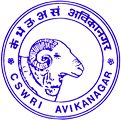
The ICAR-Central Sheep and Wool Research Institute (ICAR-CSWRI) is an Indian Council of Agricultural Research subsidiary commissioned for research, training and extension activities related to sheep and rabbits. The Institute is an autonomous body and is sponsored by the Department of Agricultural Research and Education (DARE), Ministry of Agriculture, Government of India. It is situated in Avikanagar, Malpura, in Rajasthan, India. It works in close liaison with the other ICAR institutes, Central Wool Development Board, Sheep and Wool Marketing Federation, Department of Biotechnology (GOI), Small Entrepreneurs, NGOs, State Animal Husbandry and Khadi gram and Cottage industries.
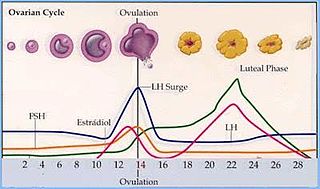
Induced ovulation is when a female animal ovulates due to an externally-derived stimulus during, or just prior, to mating, rather than ovulating cyclically or spontaneously. Stimuli causing induced ovulation include the physical act of coitus or mechanical stimulation simulating this, sperm and pheromones.

Flugestone acetate (FGA), sold under the brand name Cronolone among others, is a progestin medication which is used in veterinary medicine.
(Dorothy) Claire Wathes née Bulman is a British veterinary researcher who studies the reproduction of farm animals. She is known for her work on infertility in dairy cattle. As of 2018, she is a professor of veterinary reproduction at the Royal Veterinary College in Hatfield.
References
- 1 2 3 4 Carlson, K.M.; Pohl, H.A.; Marcek, J.M.; Muser, R.K.; Wheaton, J.E. (1989). "Evaluation of progesterone controlled internal drug release dispensers for synchronization of estrus in sheep". Animal Reproduction Science. 18 (1–3): 205–218. doi:10.1016/0378-4320(89)90022-5.
- 1 2 3 4 5 6 7 Mapletoft, J.R; Martínez, M.F.; Colazo, M.G.; Kastelic, J.P. (2003). "The use of controlled internal drug release devices for the regulation of bovine reproduction". Journal of Animal Science. 81 (14): E28–E36.
- 1 2 3 Eric Grant. 2006. Understanding CIDR. National Association of Animal Breeders. Feb 1, 2006. Retrieved March 20, 2012, from Beef Magazine: http://beefmagazine.com/mag/beef_understanding_cidr
- 1 2 3 4 5 Wheaton, J.E; Carlson, K.M.; Windels, H.F.; Johnston, L.J. (1993). "CIDR: A new progesterone-releasing intravaginal device for induction of estrus and cycle control in sheep and goats". Animal Reproduction Science. 33 (1–4): 127–141. doi:10.1016/0378-4320(93)90111-4.
- ↑ Pursley, J. R.; Wiltbank, M.C.; Stevenson, J. S.; Ottobre, J.S.; Garverick, H.A.; Anderson, L.L. (1997). "Pregnancy rates per artificial insemination for cows and heifers inseminated at a synchronized ovulation or synchronized estrus". J. Dairy Sci. 80 (2): 295–300. doi: 10.3168/jds.s0022-0302(97)75937-x . PMID 9058270.
- 1 2 Chebel, R.C.; Al-Hassan, M.J.; Fricke, P.M.; Santos, J.E.P.; Lima, J.R.; Martel, C.A.; Stevenson, J.S.; Garcia, R.; Ax, R.L. (2010). "Supplementation of progesterone via controlled internal drug release inserts during ovulation synchronization protocols in lactating dairy cows". Journal of Dairy Science. 93 (3): 922–931. doi: 10.3168/jds.2009-2301 . PMID 20172212.
- 1 2 Ainsworth, L.; Downey, B.R. (1986). "A controlled internal drug-release dispenser containing progesterone for control of the estrous cycle of ewes". Theriogenology. 26 (6): 847–856. doi:10.1016/0093-691x(86)90014-2.
- 1 2 Todoroki, J.; Kaneko, H. (2006). "Formation of Follicular Cysts in Cattle and Therapeutic Effects of Controlled Internal Drug Release". Journal of Reproduction and Development. 52 (1): 1–11. doi: 10.1262/jrd.17081 . PMID 16538030.